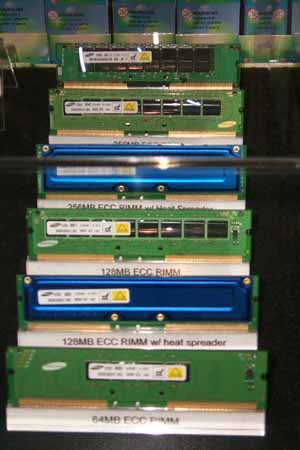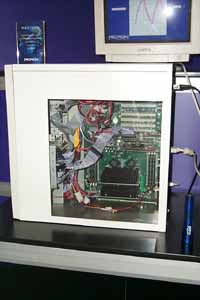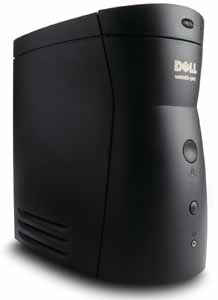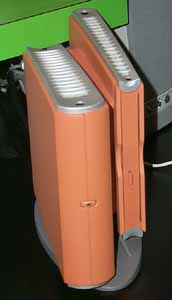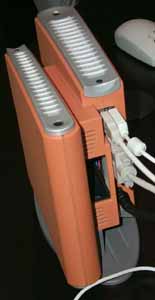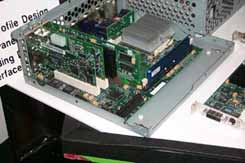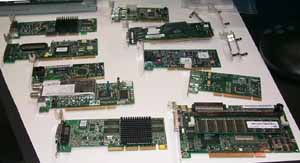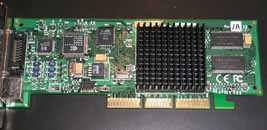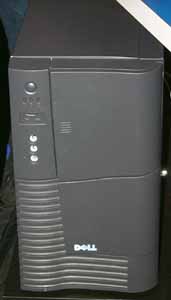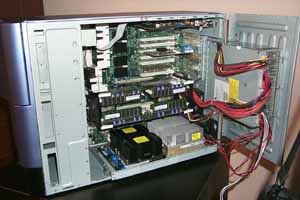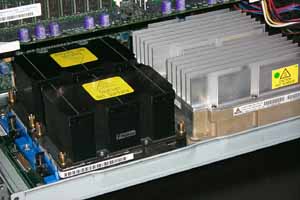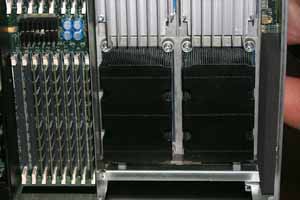
Original Link: https://www.anandtech.com/show/492
Intel IDF Report #4 - Wrap Up
by Mike Andrawes on February 29, 2000 3:15 AM EST- Posted in
- Trade Shows
 In
part 4 of our IDF coverage, we wrap things up and take a look at some of the
miscellaneous items that we saw down in Palm Springs. We didn't mention it earlier,
but the weather in Palm Springs was absolutely gorgeous. It's a shame that IDF
is moving away from Palm Springs, but hopefully the next spot will be just as
pleasant.
In
part 4 of our IDF coverage, we wrap things up and take a look at some of the
miscellaneous items that we saw down in Palm Springs. We didn't mention it earlier,
but the weather in Palm Springs was absolutely gorgeous. It's a shame that IDF
is moving away from Palm Springs, but hopefully the next spot will be just as
pleasant.
Memory Roadmap Overview
Intel made it clear time and time again that RDRAM is the primary memory technology for the future. In the desktop segment, they expect RDRAM to fill the mainstream desktop market by the end of 2000 and transition to the value segment by early 2001.
They believe that since the pin count for RDRAM is reduced compared to SDRAM, they can double the bandwidth easily. Whether this doubling in bandwidth is achieved by doubling the number of RDRAM channel, by increasing the clock, or by using a quad pumped data transfer mechanism was unclear in the presentation, but the first option seems the most likely. As mentioned in our first IDF report, the initial Tahema chipset for the Willamette processor will be RDRAM only, with support for two channels to help satiate that "400 MHz" bus.
The workstation space, where memory performance is critical, is also transitioning rapidly to RDRAM under the i840 chipset. The "2+2" configuration, meaning 2 RIMM + 2 DIMM slots, of the i820 chipset is now officially supported by Intel. Look for a number of motherboards to start popping up from virtually every manufacturer with this support. Intel did claim the difficulties they ran into with 3 RIMM's and the i820 is not unsolvable, but since current OEM's are not complaining about the 2 RIMM situation, they see little reason to play around with what works.
According to Intel, as the processor performance increases, the benefits experienced from RDRAM will increase as well. The figures they gave us now indicate a 2 - 5% benefit from RDRAM now, and they predict that as the performance of CPUs increase that figure could increase to 30%. They don't see a role for DDR SDRAM in the desktop market, which is very unfortunate, at least for the time being.
SDRAM support will continue on in the value desktop and mobile segments as well. The i815 chipset, code named Solano, will finally provide a solution to the desktop market with 133 MHz FSB, PC133 SDRAM, AGP 4x, and UDMA/66 support from an Intel chipset. Up until now, the only option for all these features has been the VIA Apollo Pro 133A. A new ICH should be introduced with the i815 as well that will include USB 2.0 support. This ICH will be used in conjunction with the i820's current MCH to produce the i820E. The i815 will have an integrated graphics core that is virtually identical to that of the i810/i810E, but also add an external AGP 4x port for upgraded graphics. While most AnandTech readers will disable the onboard graphics for any high performance rig, the onboard graphics could still come in handy for use with a second monitor. Look for the i815 in late Q2 2000.
Since there is a huge cost premium associated with RDRAM at the moment, Intel is looking to support SDRAM and DDR SDRAM on its server platforms in 2001. The problems they see, however, is that while a single chipset can support both SDRAM and DDR SDRAM, motherboard PCB layout and memory socket requirement are different between the two memory technologies, which makes the migration path difficult. Obviously, AMD and VIA think differently, so we'll see just how they deal with those issues when the release their DDR enabled chipsets later this year.
With Intel still firmly pushing RDRAM as the primary memory solution for the future, we weren't the least bit surprised to see RDRAM modules all over the show floor from every memory manufacturer. Here's a few thousand dollars worth of RDRAM at the Samsung booth:
Concept PC's
The iMac started it all and now those funky shaped, brightly colored PC's are everywhere and IDF was no exception. Intel has launched a program to recognize innovative PC designs from OEM that "advance the state of the art in innovation, simplicity, and style." The first two award winners were the Dell WebPC and the Compaq Presario EZ2000, which are currently available on the market. These two PC's are legacy free for the most part, so keyboard/mouse and all peripherals are USB based. ISA slots are gone as are serial, parallel, and game ports. The EZ2000 even features integrated Firewire support.
Other concept PC's were based around the Intel Cape Arago concept motherboard. This motherboard measured just 5.5" x 5.5" and is a full PC, complete with 64MB SDRAM soldered onboard (nonexpendable). A 40W 5V external power brick is used to power the system so the system can be extremely small with no noise caused by fans. PaloAlto had a working design that was only a few inches thick with a notebook DVD drive attached in parallel with the motherboard.
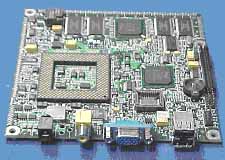 |
With the push towards increased PC usage throughout the home, with many households having multiple PC's, the time has come for these concept PC's to stop being concepts and start being reality. Don't be too surprised if you see some of these funky designs available on store shelves by the end of this year.
Low profile PCI/AGP
To help make some of those concept PC's more feasible, a new initiative is on the way to provide low profile PCI and AGP cards. There's nothing particularly special about low profile PCI/AGP - it's simply a new spec from the PCI SIG (Special Interest Group) that defines a "shorter" PCI or AGP board targeted at low profile PC's. The new boards will fit in traditional PCI/AGP slots, as the slots themselves have not changed. The only requirement for a low profile board to fit in a standard case is that the back plate be changed.
Diamond/S3's big splash at IDF was with the Viper II DVI LPF. As the name implies, it's a low profile version of the Viper II with an onboard DVI interface that can be used with digital flat panels or standard analog monitors.
ATI had a low profile version of the Rage 128 Pro AGP in addition to a low profile version of their upcoming HDTV decoder card. This follow up to the TV-Wonder, in conjunction with the Rage 128 series' support for iDCT decode in hardware, can efficiently decode HDTV signals using a PC for display on your monitor or output to a TV. The solution will be considerably cheaper than an external HDTV decoder box that most HDTV setups require at the moment.
Communications/Networking Riser - CNR 1.0
In order to help keep the cost of new PC's down, Intel has introduced the CNR 1.0 spec to support low cost/integrated network adapters. It's much like the AMR we have today in that the key components for support are located on the motherboard, while the physical layer support is on a small card. Again, just like AMR, it is designed for OEM's only and not as a retail upgrade path. CNR will comprise everything that is included in the AMR spec and essentially supercedes it. So we'll see CNR cards with modems, sound, and networking all on one card. That networking support can come in the form of standard Ethernet, HomePNA phone line networking, or both.
More Itanium
While we covered the architecture of the Itanium in Part 3 of our IDF coverage, we now have some pictures of the actual systems Intel had running. Most followed the reference Intel design, such as the Dell server/workstation shown below. However, others went with their own custom designs, such as the 16-way configuration from NEC that stands over 6 feet tall and 4 feet wide.
It is interesting to note that all the setups we saw were using SDRAM for memory support. It's also interesting to note the second massive heatsink adjacent to the Itanium CPU that covers the power supply for the chip. Below, we have some pictures of the inards of the the Itanium Server and Workstation designs that Intel was showing.
Conclusion
Overall, AnandTech's first trip to IDF was quite a fruitful one. While the show didn't have the hustle and bustle of a Comdex or an E3, we garnered quite a bit of information as well as got a chance to meet some of our friends over at Intel. As such, you can almost certainly expect to see continued IDF coverage from AnandTech in the future.


